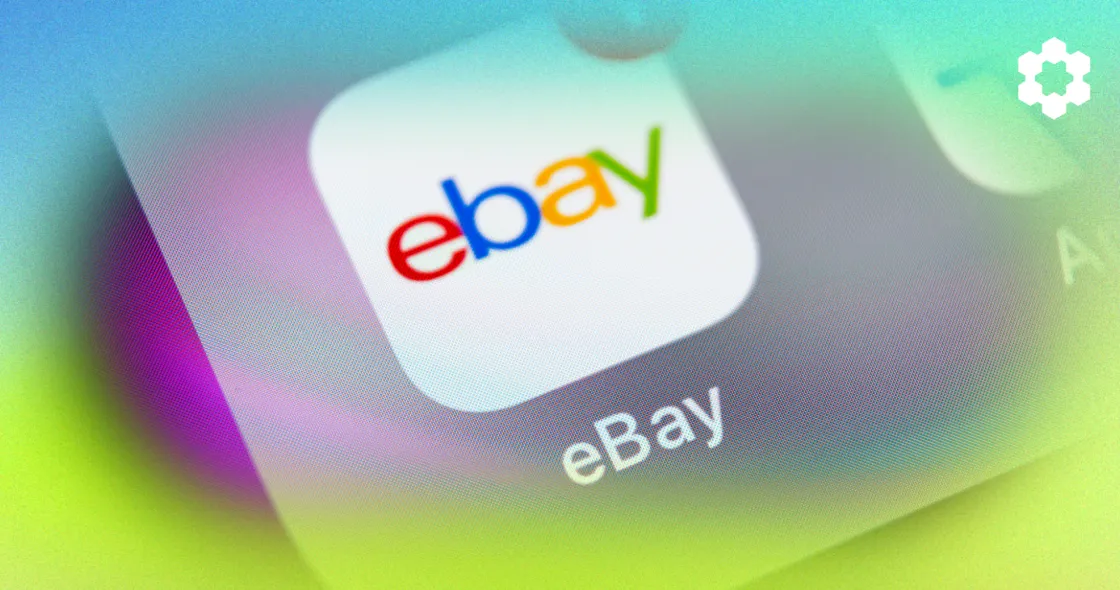When it comes to ecommerce, sellers often face a pivotal question: eBay or Amazon? (And hey, why not both?)
While it’s not quite as timeless as deciding whether to have your eggs scrambled or fried, the choice between these two ecommerce giants has become a major consideration.
In the following guide, we’ll compare eBay vs Amazon, help you understand the differences and similarities, and then show you how to maximize your profits — regardless of which platform you choose.
You’ll be happy to know you can also do both.
With the right strategy, you can tap into the unique benefits of each marketplace and diversify your revenue streams.
It all starts with understanding what sets them apart and how you can leverage their strengths.
Key Differences Between eBay and Amazon for Sellers
Let’s hit the summary definitions first, then highlight some key things that set each apart.
eBay
Founded in 1995, eBay allows users to buy or view items via retail sales through online marketplaces and websites in 190 markets worldwide.
Sales on eBay occur either via online auctions or “buy it now” instant sales, and the company charges commissions to sellers upon sales. It offers a personal (low volume; personal listings) account or a business account.
Amazon
Founded in 1994, Amazon began life as an online marketplace for books, gradually increasing its offerings until it became referred to as “The Everything Store.”
Amazon has a no-cost option for sellers, with no monthly fee and a limit of 40 items sold a month, or you can get a professional account, which is $39.99 a month with unlimited sales.
Each platform has certain strengths.
Selling Models
Like a venn diagram (those comparisons of things where two or more circles overlap), Amazon and eBay have intersecting features.
Their biggest intersection is over fixed-price listings, which both offer.
eBay also offers auction-style selling, which it first became known for. The first eBay users were mostly private sellers looking to offload random personal stuff, including things they wanted to make money on rather than donate or throw or give away.
It was a garage sale on steroids.
That model has come a long way. So has Amazon.
eBay:
- Operates more like an auction house, with auction-based and fixed-price selling models.
- Requires that sellers manage their own shipping and fulfillment.
- Has a less standardized returns policy.
- Levies lower/less fees, generally, than Amazon.
Amazon:
- Operates like a traditional retail store, where sellers compete based on price, quality, and brand reputation.
- Offers fulfillment services, handling storage, packaging, shipping, and customer service.
- Has a very customer-friendly returns policy.
- Charges higher/more fees.
A good summary might be: more autonomy on eBay, more fees on Amazon; more perks, more aids and support for the seller on Amazon, less on eBay.
The difference between eBay and Amazon is slight but significant.
What about the audiences?
Customer Base
Global Overview
Shopper traffic is a big consideration when choosing. Amazon is the king of volume, with over 300 million shoppers making at least one purchase last year, to the tune of $575 billion in sales, vs. eBay’s 132 million shoppers and $10 billion in sales.
United States
In the US, Amazon has a clear lead:
- Amazon is the top ecommerce site in the US.
- eBay ranks as the second most visited ecommerce website in the US
United Kingdom
Both platforms are popular, but Amazon has an edge:
- Amazon UK receives 407 million visits per month
- eBay UK receives 298 million visits per month
- Amazon’s UK traffic is 73% higher than eBay’s
Germany
Both platforms perform well:
- Amazon.de is ranked #1 in its category
- eBay.de is ranked #2 in its category
- 15% of eBay’s global sellers are based in Germany
Australia
Interestingly, Amazon has recently overtaken eBay:
- Amazon has become the leading marketplace in Australia for the first time
- 93% of Australians shopped on a marketplace in 2023
- However, eBay still had 61.3 million monthly visits in Australia
While both platforms attract a large number of buyers, their audiences differ in notable ways.
eBay’s Customer Base
eBay’s includes a higher percentage of younger buyers, those who tend to seek the thrill of bidding and finding deals. eBay buyers are often more price-sensitive than those on Amazon. (Though all things being relative, Amazon shoppers, like all shoppers, are sensitive to price.)
Amazon’s Customer Base
Amazon has a vast customer base (did we mention the 300 million shoppers?), with a significant portion of its shoppers being Generation X (ages 44 to 59, if you’re reading this in 2024), and predominantly female.
Product Categories
Depending on what you sell, you may opt for one platform or the other.
eBay: Strong in collectibles, used items, and unique goods
Amazon: Dominates in new products, especially books and electronics
Both are large, and both carry products in almost every category, but those are the ones in which they excel.
Comparing Selling Fees: eBay vs Amazon
When it comes to eBay vs Amazon selling fees, understanding the fee structures of both platforms is crucial for maximizing profits:
eBay Fees
- Insertion fees (for some categories)
- Final value fees: typically 10-12% of the sale price
- Optional fees for additional features
Amazon Fees
- Referral fees: usually 8-15% depending on the category
- FBA fees (if using Fulfillment by Amazon)
- Monthly subscription fee for Professional sellers
Related Factors
At eBay, each seller is assigned one of three seller levels:
- Top Rated
- Above Standard
- Below Standard
These ratings can impact visibility in search results, selling privileges, withheld funds, and other factors.
Every new seller on eBay starts at the Above Standard level.
Amazon keeps similar performance metrics, such as Order Defect Rate (ODR), inventory performance, and seller rating, which can affect your ability to list and sell products.
Calculate your potential profits on each platform using their fee calculators before deciding where to list your products.
Estimate Amazon Fees & Costs
Estimate eBay’s Fees & Costs
Which Platform is Better? It Depends on Your Business
The answer to “What’s better eBay or Amazon?” varies and depends on your objectives and specific circumstances.
Product Type: Unique or collectible items often perform better on eBay, while mass-produced goods may sell faster on Amazon.
Business Size: Small sellers or those just starting might find eBay’s lower barriers to entry appealing. In addition, eBay UK recently announced a major change: private sellers can now list items for free across all categories (except motors). This eliminates final value fees, allowing sellers to keep more profits. However, optional fees for features like Promoted Listings still apply.
Seller Support Accessibility: eBay offers 1:1 support through Seller Clinics and dedicated customer support for business sellers. Meanwhile, Amazon has 24/7 support via Seller Central, including phone, email, and advanced chat options, such as the recently announced Project Amelia.
Dispute Resolution: eBay provides additional customer support for fraudulent returns and simplified resolution processes, while Amazon offers a structured process for handling disputes, with an emphasis on customer-friendly returns.
Fulfillment Capabilities: If you want hands-off fulfillment, Amazon’s FBA program could be advantageous.
Brand Building: Amazon offers more tools for building your brand presence.
Done right, you can leverage both.
Leveraging Both Platforms: Amazon and eBay Selling Strategies
As with many things in life and business, it isn’t always necessary to choose one or the other. Many successful sellers have discovered how to make money selling on eBay and Amazon, using these platforms in tandem to maximize their reach and profits.
Techniques include:
Cross-listing: Listing products on both platforms to reach different customer bases.
Platform-specific pricing: Adjusting prices based on each platform’s competitive landscape.
Inventory management: Using multi-channel inventory software to prevent overselling.
Fulfillment optimization: This one is interesting, but, done right you can maximize your fulfillment options by using Amazon FBA for both Amazon and eBay orders.
Perhaps unsurprisingly, many of the same selling strategies apply to either platform.
- Optimize listings with high-quality photos, lifestyle images, detailed descriptions, and relevant keywords.
- Research similar listings and use competitive pricing.
- Offer coupons, promotions, and discounts as a selling tool.
- Practice stellar customer service with prompt responses and aggressive issue resolution.
- Utilize tools, such as third-party software and in-system templates and analytics to maximize efficiency and results.
- Do off-platform marketing to drive traffic.
- Stay updated on not only market trends and other sales drivers, but also platform policies, terms, and specific requirements.
Arbitrage on Either Platform: Opportunities and Risks
Arbitrage involves buying items on one platform or from one source and selling them for a profit on another. In the case of Amazon eBay arbitrage, we’re talking products.
Official definition: “The simultaneous buying and selling of products in different markets or in derivative forms in order to take advantage of differing prices for the same asset.”
Think buying paper towels at Costco for $1.05 a roll on sale, then selling them on Amazon or eBay for $1.20.
While this can be lucrative as a tactic, it comes with risks:
Price volatility: Prices can change rapidly, eroding potential profits.
Platform rules: Both Amazon and eBay have policies that may restrict certain arbitrage practices.
Competition: Other sellers may quickly copy successful arbitrage strategies.
Inventory management: the challenges can be high, with risks of overstocking (incurring storage fees, and other inefficiency costs), or understocking and missing potential sales.
There are also, of course, opportunities:
- Relatively low initial investments.
- Products can be sourced and listed quickly.
- Wide diversity of product opportunities.
- Products tend to have a pre-existing market, with proven sales histories.
eBay Seller Guide: Tips for Success
Success on eBay involves many of the things that are vital for any online entrepreneur, from planning to customer service to effective marketing.
Here are a few tips to get started:
- Product research: Do your homework and identify products that are in demand.
- Perfect your listings: Use high-quality images and detailed descriptions. Make use of eBay’s templates.
- Price competitively: We mentioned this earlier, but research the field and stay competitive on price.
- Build your feedback score: Excellent customer service is crucial on eBay.
- Utilize eBay’s promotional tools: Such as multi-buy discounts and seasonal events.
- Understand eBay’s seller limits: New sellers often face restrictions that increase over time.
- Monitor and adjust: Regularly review listings and sales performance, adjusting strategies based on what’s working and what isn’t.
No eBay seller guide would be complete without mention of eBay’s free listings. eBay offers a certain number of free listings each month, which you can use to list your items with no insertion fees.
The recent decision to go free to sell in the UK is a strategic move to remain competitive in a landscape that includes free alternatives like Facebook Marketplace and specialized auction sites.
Amazon Seller Guide: Strategies for Growth
Much has been written, recorded, spoken, and otherwise shared on the subject of selling on Amazon. Volumes of information exist. Following are a few of the fundamentals, along with links to information straight from the horse’s mouth (Amazon).
Optimize for the Featured Offer (formerly Buy Box): This is crucial for winning sales on Amazon. The Featured Offer is a window that appears at the top right of a product detail page above the Buy Now button.
Leverage Amazon’s advertising options: Sponsored Products can boost visibility and help drive better organic ranking. Amazon offers a simple primer on all of their advertising options.
Increase your results and boost your ranking on Amazon by adding in PixelMe’s off-Amazon advertising technology.
Consider Amazon FBA (Fulfillment By Amazon): This is where Amazon takes care of fulfillment and returns. FBA can improve your chances of winning the Featured Offer, along with other benefits. For more on FBA, see Amazon’s own Amazon FBA for Beginners.
Focus on product reviews: Reviews drive sales and boost ranking, significantly impacting your products’ visibility and conversion rates.
In the same way volumes of information are out there on how to grow your Amazon business, many providers also stand ready to help. From software to listing management, consulting, and knowledge sharing, a multitude of resources exist.
Carbon6 is a provider of such resources, with an engaged online community, tools, and software designed to help you succeed on Amazon.
Choosing Your Path to Ecommerce Success
In the eBay vs Amazon debate, understanding the key differences between the two is essential. But whatever you choose, each platform presents unique opportunities and challenges.
By implementing the strategies outlined in this guide, you can leverage the strengths of each platform to build a thriving and profitable online selling business.
Your path to success includes learning. Lots and lots of learning, both through guides like this one, more detailed pieces, and the best learning of all:
Experience.
Once you’ve made your decision, the best way to get that experience is to get started. You can do that with Carbon6, the all-in-one marketplace growth platform.




